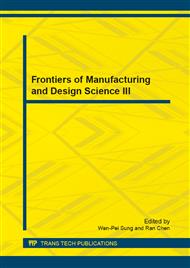p.12
p.17
p.21
p.26
p.31
p.36
p.42
p.46
p.50
Analysis of Forging Forming of 6061 Aluminum Alloy Bicycle Pedal
Abstract:
The bicycle is not only a pollution-free method of transportation, but also has sport and recreation functions. Therefore, the bicycle attracted attention in now society gradually. The purpose of this research is mainly to innovative design a forging die of pedal of bicycle for the company’s needs. We first design a die with simulation analysis of bicycle pedal by utilizing a commercial finite element package software during research process. Moreover, a series of simulation analyses with the variables depended on different press velocity of ram, temperature of die and friction factor of the die is performed to evaluate the methods of light quantification in the forging for bicycle pedal. Under various forging conditions, it analyses the curvature distribution and damage distribution of the billet. The optimal parameters to control are obtained with Taguchi methods. Finally, we identified the finite element results for high-strength design suitability of 6061 aluminum alloy bicycle pedal.
Info:
Periodical:
Pages:
31-35
Citation:
Online since:
December 2012
Authors:
Keywords:
Price:
Сopyright:
© 2013 Trans Tech Publications Ltd. All Rights Reserved
Share:
Citation:


